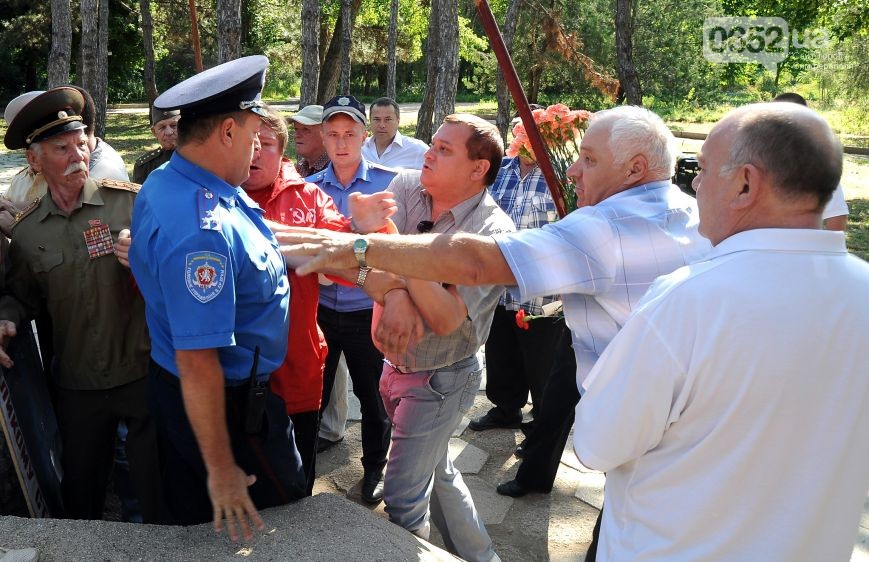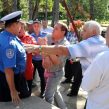
Portrait of Stalin Sparks Brawl at WWII Ceremony in Crimea
Publication: Eurasia Daily Monitor Volume: 10 Issue: 121
By:

In Ukraine, June 22 marks a day of mourning dedicated to the memory of the victims of the Great Patriotic War (Second World War). On this day, Ukrainian war veterans, military service officials and government representatives in different regions of the country come together and commemorate this somber day alongside their compatriots. This year in Crimea, that solemn day turned into a scandalous scuffle, when a national deputy of Ukraine from the Communist Party of Ukraine, Sergei Topalov, attacked the police in defense of a large portrait of Joseph Stalin that was placed next to the Eternal Flame at the Tomb of the Unknown Soldier at Simferopol’s Gagarin Park by World War II veterans and members of the Crimean Communist Party.
The scuffle started when the tomb guards (law enforcement officials) asked the veterans to remove the portrait from the premises. When the veterans refused to do this, the police officers attempted to remove the portrait themselves. Suddenly, waving his parliamentary identification card, deputy Topalov came running in defense of those veterans and physically assaulted the police officers with his fists, starting a brawl, which continued until some of the WWII veterans pulled him back (https://www.0652.ua/news/335939). In the end, the portrait of Stalin remained in its place next to the Eternal Flame, even while representatives of the Supreme Council of Crimea and the Council of Ministers of Crimea, as well as other top city officials, later came to the park to lay down commemorative flowers and wreaths. The ceremony was also attended by top politicians from Crimea and Simferopol, along with local representatives of the Party of Regions and members of the “Crimean Cossack Union.”
Defining the event as provocative, Zair Smedlaev, the head of the Secretariat of the Crimean Tatar Mejlis (de-facto parliament), stated that the presence of Stalin’s portrait during the ceremony dismissed the Crimean Tatar mass deportation from their homeland by Stalin’s orders. Moreover, Smedlaev added: “Stalin is a criminal, in accordance with the Ukrainian ‘Law of Holodomor of 1932–1933 [Famine],’ which was reviewed and accepted on January 12–13, 2010. Thereafter, a criminal court found Stalin and other leaders of the Soviet Union of that era guilty of the deaths of millions of people” (https://qha.com.ua/krimskie-vlasti-klanyalis-portretu-stalina-127943.html). Smedlaev also brought up the Organization for Security and Cooperation in Europe (OSCE) Parliamentary Assembly’s Resolution adopted on July 3, 2009, in Vilnius, which recognizes Stalinism and Nazism as criminal and condemns both regimes for having committed genocide and crimes against humanity (www.oscepa.org/members/member…/261-vilnius-declaration-english). By not requesting the removal of Stalin’s portrait from the premises and by continuing the ceremony as if nothing has happened, the Crimean political authorities became accomplices of the criminal Stalinist regime, Smedlaev argued later in an interview with journalists (https://krymtatar.in.ua/index/article/id/1012).
Crimea has been a stronghold for the Communist Party for decades. In 2002, in his book Post-Communist Ukraine, Bohdan Harasymiw defined Crimea as the “oasis of communism,” where pro-Russian deputies consist of a “combination of conservative retirees from the Soviet Communist Party, the military, and the KGB.” But eleven years later, as this recent incident indicates, although there are only nine communists (five actual members of the Ukrainian Communist Party and four without any party affiliation) in the Crimean parliament, they are still untouchable in Crimea.
Currently, there are 99 deputies in the Crimean parliament. In addition to the 9 communists, 27 parliamentarians are from the Party of Regions, 17 from the Yanukovych Bloc (Za Yanokovycha), 10 from the Kunitsin Bloc, 4 from the Yulia Timoshenko Bloc, 4 from the political party Batkivshchyna, 4 from Ne-Tak!, 7 from the Natalia Vitrenko National Opposition Bloc, 9 from the Soyuz party, and 8 from the regional Narodniy-Rukh or People’s Movement of Ukraine (https://www.rada.crimea.ua/). Of the eight deputies of Narodniy-Rukh, seven are Crimean Tatars. Although they were elected to the Crimean parliament through a regional organization, they do not have a direct party affiliation.
And while several factions exist in the Crimean parliament, most of them are like-minded and collaborate with one another, especially when it comes to anti-Western and anti-Tatar rhetoric. Currently, out of 17 members of the Yanukovych Bloc, 8 are also members of the Russian Bloc, whose members are well-known in Crimea for their sporadic attacks on Crimean Tatars and their anti-American attitudes.
In 2006, when the United States warship USS Advantage arrived in Feodosia port as a part of the North Atlantic Treaty Organization (NATO)–Ukraine joint military exercise “Sea-Breeze 2006,” the main protestors of this event included members of the Yanukovych Bloc, the “Russian Bloc,” the Russian Community of Crimea, Viktor Yanukovych’s Party of Regions, the local “Yanukovych Bloc” (za Yanukovicha), Natalia Vitrenko’s National Opposition Bloc, as well as the Crimean Cossack Union. These protestors carried banners, such as “NATO is worse than the Gestapo,” burned US flags, and chanted anti-American slogans until the Advantage left Crimea, succumbing to the will of the protestors (Krimskaya Vremya, June 10, 2006).
Many of these same actors were also involved in attacks against Crimean Tatars with rocks, hand grenades, Molotov cocktails and fog bombs at the Azizler (Saints) holy site in the Crimean city of Bahchesaray on July 8, 2006 and later on August 12, 2006 (ukranews.com, August 18, 2006). During these attacks, the then-leader of the Russian Bloc, Oleg Rodiviliov, a deputy in the Crimean upper parliament, was captured on film instigating the attacks. This video was broadcast on Crimean television Channel 10 numerous times (https://news.allcrimea.net/news/2007/11/07/1194434019). The two attacks left approximately 100 Crimean Tatars seriously injured with brain damage and broken bones, yet no arrests were made (https://www.usubc.org/AUR/aur851.php#a12).
The June 22 event indicates that seven years after these conflicts, the same groups and individuals are still enjoying the benefits of their political status in Crimea, and willfully lay flowers next to Stalin’s portrait. In doing so, they disregard the significance of their action as well as the 2009 OSCE Resolution against totalitarianism, even though in January 2013 Ukraine assumed the OSCE chairmanship.




